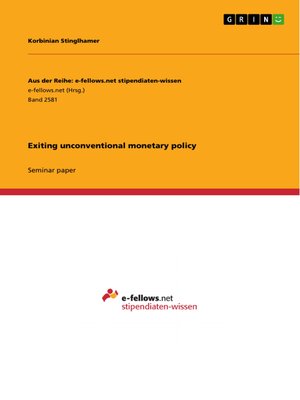Exiting unconventional monetary policy
ebook ∣ Aus der Reihe: e-fellows.net stipendiaten-wissen
By Korbinian Stinglhamer

Sign up to save your library
With an OverDrive account, you can save your favorite libraries for at-a-glance information about availability. Find out more about OverDrive accounts.
Find this title in Libby, the library reading app by OverDrive.



Search for a digital library with this title
Title found at these libraries:
| Library Name | Distance |
|---|---|
| Loading... |
Seminar paper from the year 2016 in the subject Economics - Finance, grade: 1,0, University of Wisconsin-Madison (Economics), course: The Financial System, language: English, abstract: The paper analyzes the unconventional monetary policies that were implemented by the Federal Reserve Bank, the Bank of England, the European Central Bank, and the Bank of Japan during their post-crisis transitions. Next, potential challenges involved in the exit will be analyzed. During the financial crisis many central banks in the world implemented "unconventional monetary policy" measures, such as balance-sheet policies, forward guidance, and negative interest rates. Once the financial system stabilizes, the difficult process of returning back to conventional monetary policy begins. For this reason, this paper analyzes the unconventional monetary policies during post-crisis transitions and potential challenges involved in the exit. The analysis suggests that a transition from unconventional monetary policies should be accomplished smoothly, without exceeding inflation, harming economic recovery, or destabilizing financial markets. Furthermore, the analysis suggests to make use of forward guidance in order to prepare the market for the exit and to increase its potential speed. However, the optimal exiting policy depends largely on present and future economic conditions of the respective currency region. In order to analyze these conditions and determine the ideal exiting strategy for each central bank, further investigations need to be done.







